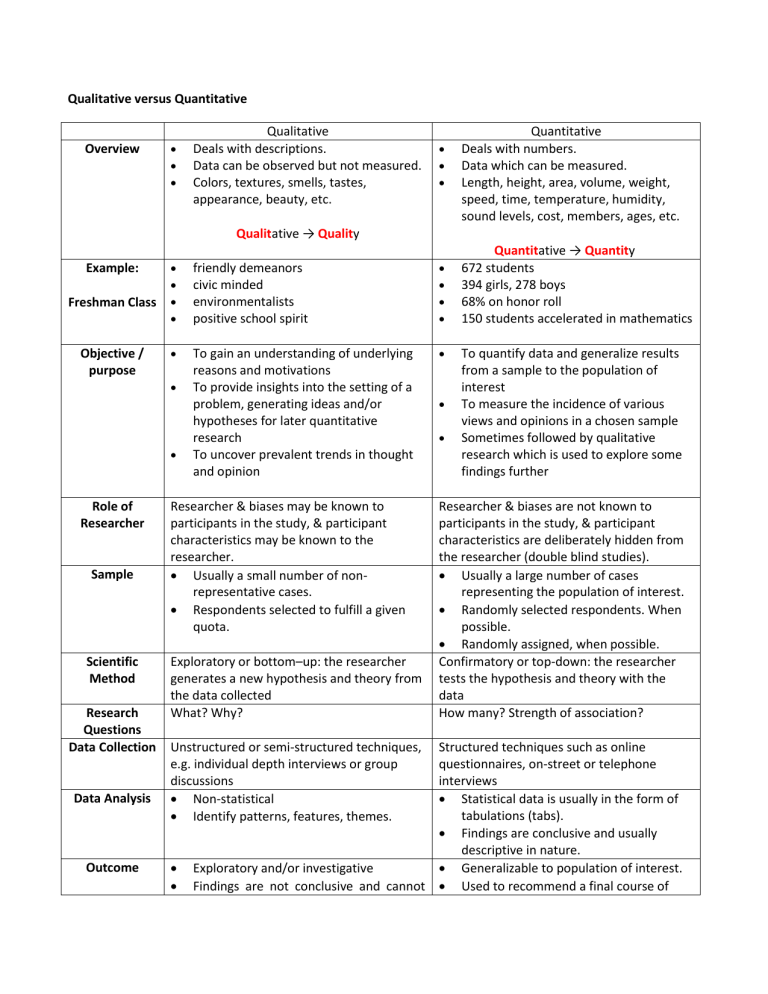
Qualitative versus Quantitative Overview Qualitative Deals with descriptions. Data can be observed but not measured. Colors, textures, smells, tastes, appearance, beauty, etc. Quantitative Deals with numbers. Data which can be measured. Length, height, area, volume, weight, speed, time, temperature, humidity, sound levels, cost, members, ages, etc. Qualitative → Quality Example: Freshman Class Objective / purpose friendly demeanors civic minded environmentalists positive school spirit To gain an understanding of underlying reasons and motivations To provide insights into the setting of a problem, generating ideas and/or hypotheses for later quantitative research To uncover prevalent trends in thought and opinion Role of Researcher Sample Scientific Method Research Questions Data Collection Data Analysis Outcome Researcher & biases may be known to participants in the study, & participant characteristics may be known to the researcher. Usually a small number of nonrepresentative cases. Respondents selected to fulfill a given quota. Exploratory or bottom–up: the researcher generates a new hypothesis and theory from the data collected What? Why? Unstructured or semi-structured techniques, e.g. individual depth interviews or group discussions Non-statistical Identify patterns, features, themes. Quantitative → Quantity 672 students 394 girls, 278 boys 68% on honor roll 150 students accelerated in mathematics To quantify data and generalize results from a sample to the population of interest To measure the incidence of various views and opinions in a chosen sample Sometimes followed by qualitative research which is used to explore some findings further Researcher & biases are not known to participants in the study, & participant characteristics are deliberately hidden from the researcher (double blind studies). Usually a large number of cases representing the population of interest. Randomly selected respondents. When possible. Randomly assigned, when possible. Confirmatory or top-down: the researcher tests the hypothesis and theory with the data How many? Strength of association? Structured techniques such as online questionnaires, on-street or telephone interviews Statistical data is usually in the form of tabulations (tabs). Findings are conclusive and usually descriptive in nature. Exploratory and/or investigative Generalizable to population of interest. Findings are not conclusive and cannot Used to recommend a final course of Designs Examples of Method Perspective Data Final Report be used to make generalizations about the population of interest. Develop an initial understanding and sound base for further decision making The design emerges as the study unfolds. Case Study Ethnography Phenomenology Heuristic Grounded Theory Subjective: individual interpretation of events is important, e.g., uses participant observation, in-depth interviews etc. Wide-angle lens; examines the breadth & depth of phenomena Data is in the form of words, pictures or objects Narrative report with contextual description & direct quotations from research participants. action All aspects of the study are carefully designed before data is collected. Experimental Quasi-experimental Correlational Surveys Objective: seeks precise measurement & analysis of target concepts, e.g., uses surveys, questionnaires etc. Narrow-angle lens; tests a specific hypotheses Data is in the form of numbers and statistics Statistical report with correlations, comparisons of means, & statistical significance of findings. References Creswell, J.W. (1994). Research Design: Qualitative and Quantitative Approaches. Sage Publications: Thousand Oaks, CA. Johnson, B., & Christensen, L. (2008). Educational research: Quantitative, qualitative, and mixed approaches (p. 34). Thousand Oaks, CA: Sage Publications. Lichtman, M. (2006). Qualitative research in education: A user’s guide (pp. 7-8). Thousand Oaks, CA: Sage Publications. Roberts, D. (2012). Qualitative vs quantitative data. Retrieved http://www.regentsprep.org/regents/math/algebra/AD1/qualquant.htm Snap Surveys Ltd. (2012). Qualitative vs quantitative research. Retrieved from http://www.snapsurveys.com/techadvqualquant.shtml


